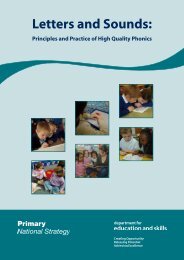Letters and Sounds: Phase Five
Letters and Sounds: Phase Five
Letters and Sounds: Phase Five
You also want an ePaper? Increase the reach of your titles
YUMPU automatically turns print PDFs into web optimized ePapers that Google loves.
<strong>Letters</strong> <strong>and</strong> <strong>Sounds</strong>: <strong>Phase</strong> <strong>Five</strong><br />
0<br />
Assessment<br />
(See ‘Notes of Guidance for Practitioners <strong>and</strong> Teachers’, page 16.)<br />
By the end of <strong>Phase</strong> <strong>Five</strong> children should:<br />
■<br />
■<br />
■<br />
■<br />
■<br />
■<br />
■<br />
6.<br />
7.<br />
8.<br />
9.<br />
Remind the children that a space is needed between words <strong>and</strong> put a mark<br />
where the next word will start.<br />
Ask the children to say the sentence again.<br />
Ask for the next word <strong>and</strong> ask what letters are needed.<br />
Repeat for each word.<br />
10.<br />
Ask about or point out the full stop at the end of the sentence.<br />
Independent writing<br />
When children are writing, for example in role-play areas, their letter knowledge<br />
along with their ability to segment will allow them to make a good attempt at<br />
writing many of the words they wish to use. Even though some of their spellings<br />
may be partially inaccurate, the experience gives them further practice in<br />
segmentation <strong>and</strong>, even more importantly, gives them experience in composition<br />
<strong>and</strong> makes them see themselves as writers. Children should be able to spell most<br />
of the 100 high-frequency words accurately during the course of <strong>Phase</strong> <strong>Five</strong>.<br />
give the sound when shown any grapheme that has been taught;<br />
for any given sound, write the common graphemes;<br />
apply phonic knowledge <strong>and</strong> skill as the prime approach to reading <strong>and</strong> spelling<br />
unfamiliar words that are not completely decodable;<br />
read <strong>and</strong> spell phonically decodable two-syllable <strong>and</strong> three-syllable words;<br />
read automatically all the words in the list of 100 high-frequency words;<br />
accurately spell most of the words in the list of 100 high-frequency words;<br />
form each letter correctly.<br />
<strong>Letters</strong> <strong>and</strong> <strong>Sounds</strong>: Principles <strong>and</strong> Practice of High Quality Phonics<br />
Primary National Strategy<br />
00281-2007BKT-EN<br />
© Crown copyright 2007
















